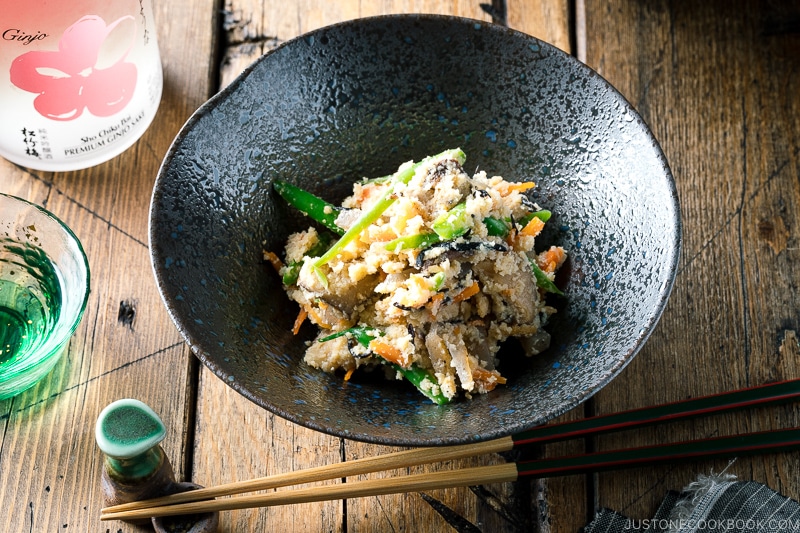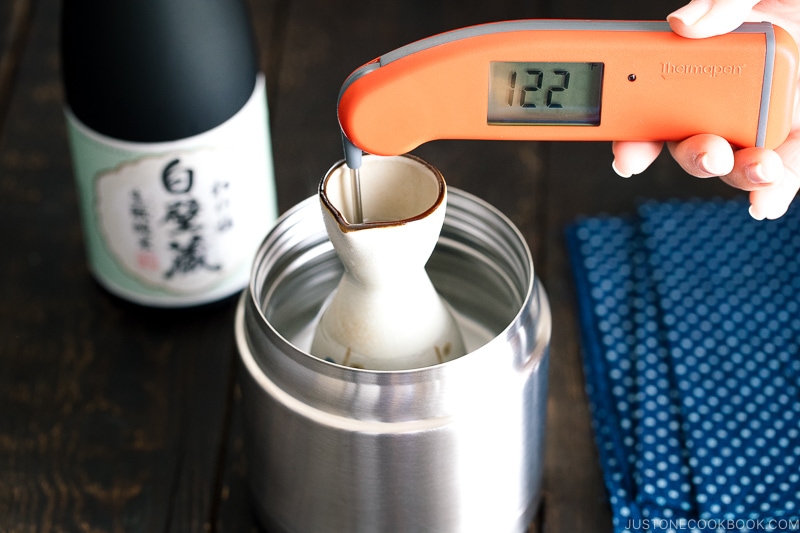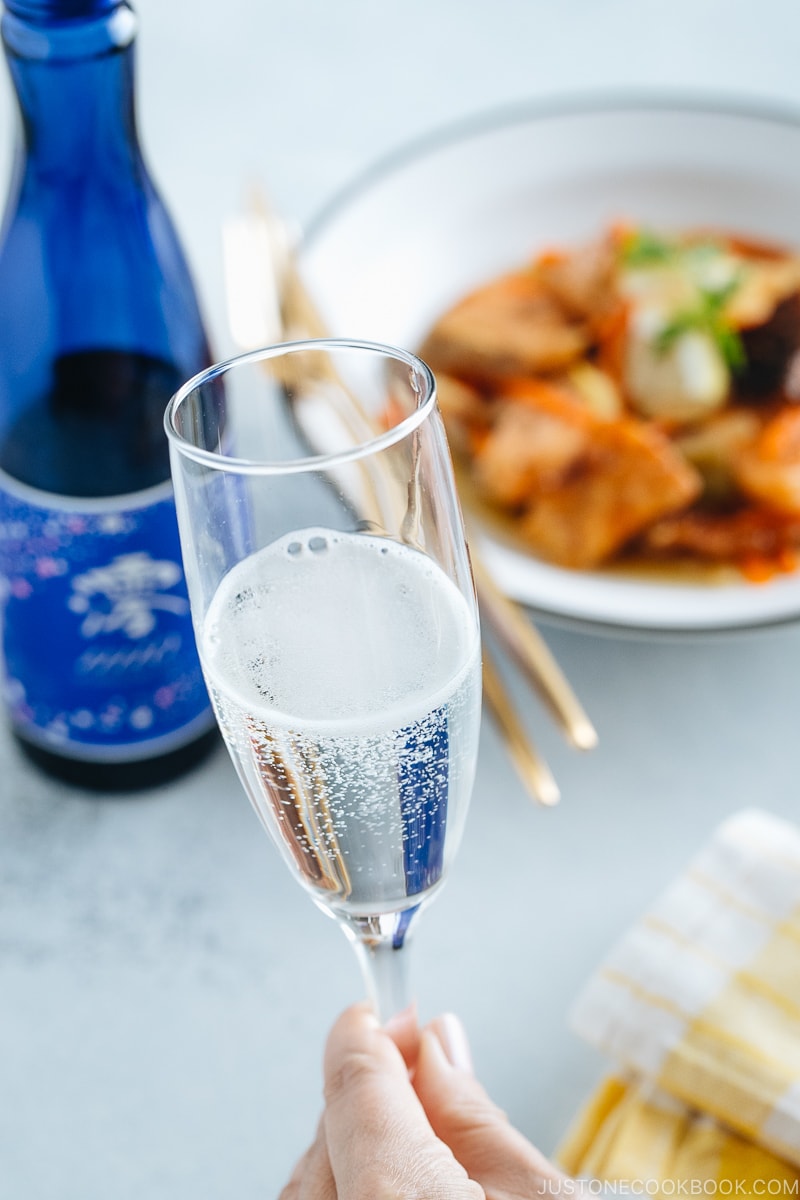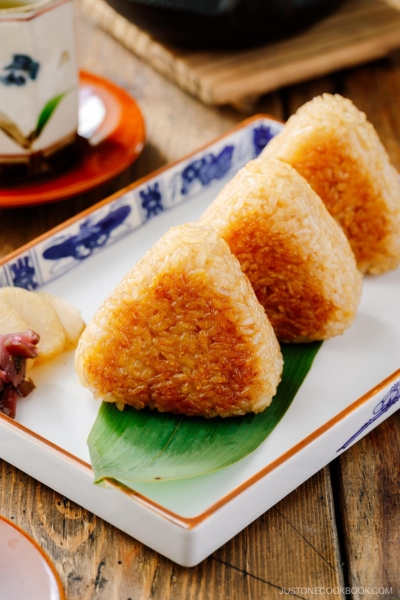Want to know how to enjoy sake? We’ll equip you with the necessary knowledge to elevate your sake-drinking experience at home or in restaurants.

Let’s get started on how to drink sake!
There are a lot of factors when it comes to drinking sake, but remember to keep it simple and fuss-free. Feel free to experiment and go wild, despite what experts and even this post will advise. After all, the ultimate goal is to drink and savor the experience! Whether you’re drinking at home or restaurants, with friends, or by yourself, here’s a guide on how to enjoy sake.
Table of contents

This is the second of a four-part series delving into the world of sake.
- What is sake, how is it made, who are the people involved
- How to enjoy sake, such as the different temperatures, drinking vessels, and how to store the bottles
- The rich history of sake throughout Japanese civilization
- How sake is intertwined with Japanese culture and seasonal events
Enjoy Sake at Different Temperatures
What’s unique about sake compared to other alcoholic beverages is its wide range of drinking temperatures, which can dramatically change its aroma and taste. You can warm or chill sake or serve at room temperature depending on the paired foods, the season, and the mood! Although there are some guidelines, there are no complex rules for sake temperature, so explore and taste how the same sake transforms.

Warmed sake is the traditional way of drinking sake, as chilled sake has become possible thanks to refrigeration technology within the last 50 years. However, it has a bad reputation, and some experts may deter you from heating it. One of the reasons is that heating can make cheap sake palatable, which mellows out the harshness. You may be surprised to taste how the sake opens up if you buy quality sake and do it yourself or order from a trustworthy restaurant!
Sake temperatures are roughly categorized into three groups.
- Reishu (冷酒) “cold sake”
- Chilled sake. The flavor, aroma, and sweetness are subtle, and the alcohol is sharp and strong
- Hiyazake (冷や酒) “room temperature sake”
- Sake around 20-25C/68-77F. You can taste the flavor and aroma as it is
- Kanzake (燗酒) “warm sake”
- Warm sake, which smooths out and mellows the alcoholic flavors and acidity and brings out the sweetness and umami

Japanese Expressions for Sake Temperatures
The Japanese have colorful expressions to describe the various degrees of sake temperatures to break this further down. Even a 5C difference can change its profile!
- Yuki-bie (雪冷え) “snow chilled” = 5C/41F
- Hana-bie (花冷え) “flower chilled” = 10C/50F
- Suzu-bie (涼冷え) “cool chilled” = 15C/59F
- Jou-on (常温) “room temperature” = 20C/68F
- Hinata-kan (日向燗) “sunshine warm sake” = 30C/86F
- Hitohada-kan (人肌燗) = “body temperature warm sake” = 35C/95F
- Nuru-kan (温燗) “warm sake” = 40C/104F
- Jo-kan (上燗) “superior warm sake” = 45C/113F
- Atsu-kan (熱燗) “hot warm sake” = 50C/122F
- Tobikiri-kan (飛び切り燗) = “extremely warm sake” = 55C/131F
- Acchichi-kan (あちち燗) = “super warm sake” = 60C/140F
Sake Temperature Tips

- When pairing foods with sake, try pairing the sake temperature with the food. Serve chilled sake with chilled food, room temperature sake with room temperature food, and so on
- Drink warm sake in small cups so that it won’t cool down quickly
- The general advice is to refrain from warming gingo, daiginjo, namazake, and carbonated sake. Heating sake loses some of its delicate flavor and aroma
How to Heat Sake
To heat sake, heat a small pot of water until boiling, turn it off, and submerge a tokkuri with sake inside. The sake will warm up in one to three minutes. You could also use a chirori (ちろり) or tanpo (たんぽ).
You could also microwave the tokkuri. Be careful of the contents exploding in the microwave as this unevenly heats the sake. But microwaving is convenient, so if you do, check on it as it heats up and stir the contents to distribute the heat.

How to Count and Serve Sake
Ready to pop open a bottle and enjoy sake? Let’s get acquainted with the various sake units and terminologies.
Sake Units
- Issho-bin (一升瓶) 1.8l/60.8oz
- You’ll see these magnum bottles at restaurants and izakaya (Japanese gastropubs)
- Yongou-bin (四合瓶) 720ml/24oz
- Slightly smaller than a wine bottle, best for home drinkers. It fits in most home refrigerators
- Ichigou (一合) 180ml/6oz
- The standard size of a tokkuri or masu
- Cup sake (カップ酒) 180-300ml/6-10oz
- Individual servings for easy drinking come in glass cups with a lid. It has a reputation for being low quality, but there has been growing interest in these accessible single-serving sizes

Sake Vessels
Sake is usually transferred into a smaller vessel for easy pouring. These vessels hold around 180-360ml/6-12oz (1-2 gou). This makes it much easier to pour sake into cups than heavy bottles.
- Tokkuri (徳利) come in various sizes, from tall and narrow to gourd-shaped. It has better heat retention than katakuchi due to its small mouth. Use tokkuri for cold, room temperature, and warm sake
- Katakuchi (片口) has a squat shape with a wider mouth. It is not suitable for warm sake as the sake will cool due to the open mouth
- Chirori (銚釐) is used to warm or chill sake and is made of metal such as bronze, tin, aluminum, or stainless steel. It has a flip lid and looks like an elongated teapot. It is half submerged in hot or ice water, which can be served at the table as is or transferred into a tokkuri
- Tanpo (湯婆) is similar to a chirori, except it doesn’t have a lid and has a wider mouth. The term is generally used in the Kansai area (although nowadays, chirori and tanpo are used interchangeably)

Sake Cups
Like drinking wine from a Riedel glass versus a mason jar, the drinking cup can significantly affect and elevate your experience. It can alter the aroma, sweetness, and even the temperature of the sake. Unlike wine or beer, where the vessel is always glass, sake cups can range from earthenware, porcelain, lacquer, bamboo, and Japanese cedar, and the wall thickness can be thick or thin.
- Ochoko (お猪口) are the smallest cups. Small and squat, it can hold 20-50ml/6.7-16.9oz of liquid
- Sakazuki (盃) is the oldest sake cup; it resembles shallow, almost flat plates. Initially, the nobility used sakazuki made of lacquer at banquets and ceremonies. Nowadays, they are used for special occasions such as wedding rites and the New Year celebration
- Gui nomi (ぐい呑) are much bigger than ochoko, making for heavier drinking. They tend to be made of sturdy material and held with one hand
- Masu (枡) are wooden boxes initially used by merchants as a measurement tool and as cups. You may see masu with a glass cup inside to catch the generous sake pour. You can drink the sake directly from the masu or tip the contents into the glass
- Kiriko (切子) is a traditional craft of cut glass with intricate patterns
- Sake glasses are for cold sake. They can range from regular drinking glasses to wine glasses made explicitly for sake

Use the Correct Sake Cups to Enjoy Sake
Baffled by the choices? Here are a few tips to keep in mind when drinking sake:
- For cold sake, choose ochoko made of porcelain, glass, earthenware, or metal ochoko
- For warm sake, retaining heat is vital! Use cups with thick walls, such as porcelain or earthenware, and avoid glass, metal, and wood. Using small cups and warming the tokkuri in warm water will also help heat retention.
It ultimately comes to personal preference, so feel free to experiment and find the perfect drinking cups that fit your needs.
How to Read A Sake Bottle Label
You’ll find a lot of information printed on a sake label. The legally required information is the product name, the producer’s name and address, alcohol content, date of production, and more. Some have additional information, such as the rice milling rate, acidity, the sake meter value, and a message from the brewery.
First, when browsing through sake bottles, check the sake category (honzojyo, junmai, ginjo, etc). That will give you a rough idea of what to expect.
For additional reading, read How to Read Sake Bottle Labels.

How to Store Sake
Like wine, properly storing open and unopened bottles of sake is vital in preserving and extending flavor.
Avoid exposing the bottles to sunlight and fluorescent lighting, whether stored in the refrigerator or a cool place. When buying sake at the store or online, ensure the bottles have been properly stored and managed through shipping. Direct sunlight, especially UV rays, will degrade the sake.
Always store sake bottles upright. Keeping it on its side will put the sake in contact with the metal cap, which may affect the flavor. Storing bottles upright reduces the amount of sake exposed to air, slowing oxidation compared to bottles stored on its side.
Refrigerate Opened Sake
It’s best to store opened sake in the refrigerator to minimize oxidation, especially delicate sake such as ginjo, daiginjo, and namazake. Some experts recommend using a vacuum pump for wine to prevent oxidation, although this may also lose the sake’s delicate aroma. You could also transfer the leftover sake into a smaller bottle to decrease air exposure. For the best quality and experience to enjoy sake, try to finish up the bottle as soon as possible.
Sake has no expiration date as the high alcohol content prevents rapid deterioration and keeps the sake relatively stable. You could keep unopened and properly stored bottles for years.

Etiquettes to Enjoy Sake
While drinking etiquette tends to be more casual with friends or family than in a business environment, knowing some manners will impress your peers! To avoid offending your fellow dining companions, it is imperative to adhere to proper drinking etiquette at a business dinner.
Drink sake over multiple sips, and don’t take shots or large gulps. Remember to be mindful of others when drinking, and don’t feel compelled to drink more than you can or pressure others to drink. Keep it fun!

When Receiving a Sake Pour
- If someone offers you a drink, hold the cup from the side with your right hand and put the cup in your left hand. Don’t hold the cup with one hand
- Always acknowledge and thank the person who poured you a drink, even if it’s just a nod or smile
- Once you receive a drink, take a sip before putting the cup down. Don’t finish the entire pour, even if the cup is small
When Pouring Sake
- Before pouring a drink, ask the person if s/he would like a refill
- To pour sake into a cup, use both hands. Hold the tokkuri from the top with your right hand so that the back of your hand is facing up, and put your left hand at the bottom near the opening (vice versa if left-handed)
- When pouring sake into the cup, fill it 80% full unless s/he asked for less
- If you see a cup that’s 1/3 empty, ask that person if s/he would like more

Helpful Tips When Drinking With Company
- Make sure to drink water throughout the drinking session to stay hydrated
- It’s courtesy to pour drinks for others but not for yourself, so if you see someone about to pour her/himself a glass, offer to pour one for that person (although some may decline these formalities)
- If the tokkuri is empty, don’t lay it down, as it may roll off the table
- Don’t shake the tokkuri or look inside to see if there’s any leftover. Just pour it out
- If there’s sake still in the cup, don’t pour a different sake. If at a restaurant, the servers will bring new cups for each sake, don’t reuse the same cup
- Feel free to refuse if someone offers a refill politely. Do not flip the cup, as this is a sign of rejecting sake and can even signify breaking up relations with your drinking companions

Readers’ Questions about Sake
Here are some questions submitted by our dear readers about sake. Although I’m an amateur sake drinker, I hope this answers some of your pending conundrums.
Q: What sake do you recommend for beginners?
There are so many varieties of sake, which may be intimidating for beginners!
If you like carbonated beverages or bubbly wine, try sparking sake (スパークリング清酒). There is clear sparkling sake and sake with a cloudy appearance. This residue comprises rice, koji, and yeast particles from sake production. Some types of sparkling sake undergo a second fermentation in the bottle, similar to Champagne. Others have added carbon dioxide gas, which tends to be more affordable. The taste can range from sweet to dry, and there are also low-alcohol varieties (~5% ABV). Sparkling sake is the newcomer to the vibrant sake scene, so pick up a bottle if you can!
Junmai-shu (純米酒), made with rice, koji, and water, is another good choice for newcomers. It’s mellow, umami-rich, and is excellent chilled, warmed, or at room temperature. You taste the pure rice flavors, as the rice polishing is minimal, about 20%. This flavor can taste light or heavy depending on the temperature.
Honjozo-shu (本醸造酒), sake with distilled alcohol, is another recommendation. The fortification is not a sign of poor quality or inferiority to other varieties. It’s not any sweeter or higher in alcohol, either. Instead, the added alcohol makes it mellow, smooth, and shelf-stable. As honjoshu is lighter and drier than junmai, it’s versatile in different temperature ranges. It also tends to be cheaper and is basically like table wine – nothing too complex and easy to pair.
You could also choose from sake rice. Yamadanishiki (山田錦), AKA “the king of sake rice,” is the most popular, commonly grown, and expensive. The price and variety range from affordable to the highly prized junmai daiginjo.
Q: I had frozen sake at a restaurant before. Is this a typical drink in Japan?
Touketsu-shu (凍結酒, “frozen sake”) is a specialty frozen sake that has a slushie or granita-like texture. Because it’s icy cold, you won’t notice the aroma or complexities, but you’ll taste the natural sweetness of the rice. It’s not a standard drink; not all breweries produce this type of sake.
Mizore-sake (みぞれ酒, literally “sleet sake”) is any sake served frozen. You could make it by freezing sake in a tokkuri or ziplock bag.
Q: What’s a suitable sake to drink at room temperature or warm?
Junmai and Honjozo are great at room temperature or warm. Like steamed rice tasting more delicious than fridge-cold rice, warmed sake brings out the inherent sweetness and umami. Find a full-bodied and umami-rich sake for the ultimate experience. Check the sake label as some list suggestions on drinking temperatures.
Don’t be discouraged if you had a terrible encounter with warm sake. As heating sake mellows the harshness of the alcohol, it can also mask low-quality sake. The best way is to buy a good bottle and do it yourself. Warming does open up the flavors, and you may taste an entirely different sake! Do give it a go!
As for other types of sake, it’s not taboo to warm delicate sake like ginjo. Sake experts may warn you against it as you lose the fragrant, fruity aroma and taste. Do have an open mind when it comes to testing sake temperatures!
Q: How do I warm sake?
Like warming a coffee mug before pouring, warming the tokkuri and ochoko is vital for heat retention. To warm the vessels, pour hot water into the tokkuri and ochoko, rinse them, and pour out the contents.
Bring a small pot of water to a boil to warm the sake, then half-submerge the tokkuri with the sake inside. You could use a large bowl or donburi if you don’t have a pot. Either way, ensure enough hot water submerges the tokkuri to the neck.
You could also microwave the tokkuri with sake, but this method unevenly heats the sake.
It depends on the material and thickness of the tokkuri, but 1-3 minutes should suffice. If you’re unsure, do a quick taste. You could also use a thermometer to measure the temperature precisely.
Q: What’s the difference between sake and ryorishu?
Ryorishu (料理酒) is cooking sake. Like cooking wine, ryorishu often has additives to make it shelf-stable. To enable shops without a liquor license to stock it, manufacturers are required by law to add salt to make it undrinkable. It’s also cheaper than drinking sake, but it’s not made for drinking! (Some classmates at my culinary school tried it and vowed never to do it again.)
Q: Is mirin just a sweeter version of sake?
Mirin (味醂) is sweetened sake. While nowadays, it’s used in cooking to add sheen to the final dish, mirin was historically also drunk like sake. During the Edo period, mirin was a high-end alcohol, popular for its natural sweetness when sugar was a luxury. It’s made of glutinous rice, koji, and distilled alcohol (sake contains short-grain rice, koji, and yeast) and follows a similar process to sake production. It also has 14% alcohol, similar to sake.
For more, please read Japanese Pantry Essentials: Sake vs Mirin
Q. Are there sake infusions?
Yes! You can enjoy some exciting sake infusions if you can find the ingredients!
Hire zake (ひれ酒, “tail fin sake”) is hot sake steeped with charred blowfish fin. To finish, the sake is lighted to evaporate the alcohol and then covered for a moment before serving. It tastes like light dashi and is smoky from the charred flavor. It is not fishy.
Ika tokkuri (いか徳利, “squid tokkuri”) is a tokkuri shaped out of dried squid body. Sometimes, it comes accompanied by a squid ochoko as well. This is also sipped with hot sake as it picks up the salty flavors. Over several pours, the dried squid softens to a jerky-like texture, which you can eat at the end.
Koura zake (甲羅酒, “shell sake”) is hot sake poured into crab shells. Crab, especially king crab, is a delicacy, and what better way is there to savor the last morsel? You can make it with steamed or grilled shells. If you can’t find crab shells, use grilled or boiled crab legs infused with a cup of sake.
You may encounter sake cocktails outside of Japan, but you won’t find many creative endeavors in Japan. After all, you can easily find high-quality sake that doesn’t need masking with flavors.
Umeshu (plum wine) is Japanese plums soaked in 35% ABV. It can also be made of distilled alcohol, such as brandy, gin, shochu, and vodka. For home use, you don’t make it with sake due to Japanese liquor laws, as the alcohol levels are too low, and it may spoil.
Q: Which prefecture has the best sake?
I hesitate to say which because every region has its specialty and styles. And every region boasts of their local sake!
The historically famous breweries are in Hyogo and Kyoto prefectures, many operating for several generations. Niigata is the prefecture with the highest sake consumption, followed by Akita and Yamagata. Not coincidentally, they also are major rice-growing regions. On average, an adult in Niigata drinks 10.5 liters per year! In comparison, Tokyoites rank 14th.
Q: How can I pair sake at home? What are some tips and tricks to make it work?
Recreating a sake pairing worthy of Japanese restaurants may seem difficult. But as sake is not strong in tannins and acidity, it doesn’t compete with food like wine can. While pairing with Japanese food tends to be the default, feel free to experiment with non-Japanese cuisine!
Here are some tips and tricks to make it work.
First, match the food and sake temperature—chilled sake with cold foods, like sashimi or cold cuts. You don’t want to consume uneven-temperature food and sake together for a lukewarm experience.
Second, match by flavor—lightly seasoned food with light and heavy foods with heavy sake. For example, white fish, white meat, and vegetable salad with light sake, like daiginjo or namazake. Fatty foods like beef, pork, and oily fish pair well with bold sake like junmai and yamahai.
Here are some ideas for sake pairings.
If drinking cold sake
- Sushi and sashimi
- Octopus carpaccio
- Salmon nanbanzuke
- Ankimo
- Burrata crostini with ikura and yuzu pepper
If drinking room temperature sake
If drinking warm sake
- Oden and hot pot
- Buri daikon
- Grilled fish such as mackerel, miso salmon, hamachi kama
- Braised pork belly
Do you have memories of drinking sake with friends and family? Any tips on drinking sake at home? Please share in the comment box below!








No mention of a masu???
Hi Clint, I mentioned masu under the section “sake cups.” Please take a look!
Several years ago at a restaurant, we were served sake that was very interesting. It was liquid while in the bottle but upon contact with the glass sake cup, it became a frozen slush. It was probably not a proper way to serve it but it was cool. Is it from freezing the bottle and cup or is it the type of sake that creates this frozen drink.
Hi Ellen. To answer your question, there are frozen sake called touketsushu (凍結酒) that has a slushie or granita-like texture, but that’s due to freezing the sake (could be nigori, namazake, ginjo or the like). I can’t tell what you had at the restaurant, could be a specialty at that restaurant?
What is the good brand for room temp and warm sake?
Hi Priya, sorry to disappoint you, but it’s hard to recommend a brand of sake because I don’t know what you’re able to get where you are. But I can recommend a sake variety: either honjozo or junmai. Honjozo tends to be crisp and dry whereas junmai tends to be full-bodied. Both are good at room temp and warmed. Hope this helps!
For cooking, is ryorishu a recommended sake substitute?
Hi Bernie! Ryorishu is actually cooking sake (the Chinese characters are literally “cooking sake” 料理酒) so it has alcohol. For a non-alcoholic substitute, try
> The closest substitution for sake is dry sherry or Chinese rice wine.
> If you cannot consume alcohol, you can replace it with water or broth when a recipe calls for sake for steaming or making a sauce.
Nami has written about this topic on Japanese Pantry Essentials: Sake vs Mirin